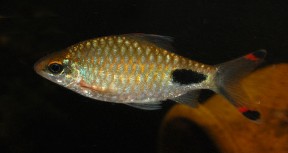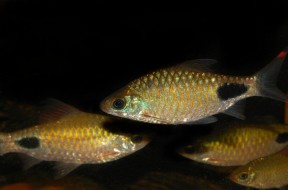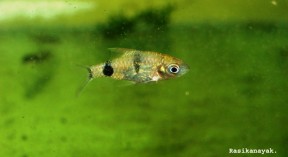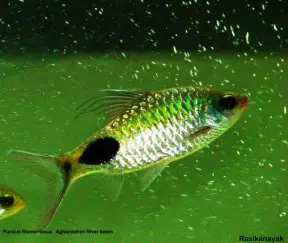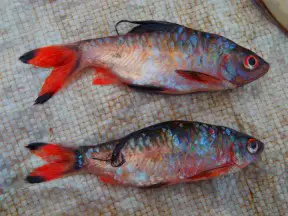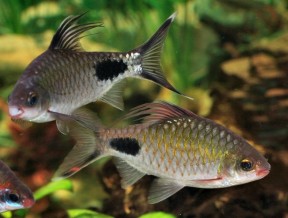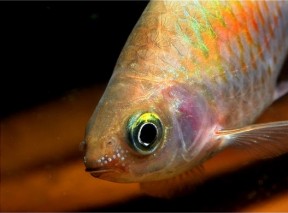Dawkinsia filamentosa
Filament Barb
SynonymsTop ↑
Leuciscus filamentosus Valenciennes, 1844; Puntius filamentosus (Valenciennes, 1844); Systomus maderaspatensis Jerdon, 1849
Etymology
Dawkinsia: named for Richard Dawkins, for ‘his contribution to the public understanding of science and, in particular, of evolutionary science’.
filamentosa: from the Latin filamentosa, meaning ‘filamentous’, in reference to the dorsal-fin extensions which develop as the fish mature.
Classification
Order: Cypriniformes Family: Cyprinidae
Distribution
Endemic to but widespread within the Western Ghats mountains region of southern India in the states of Kerala, Tamil Nadu and Karnataka, and possibly restricted to the south of the latter.
Type locality is ‘Alleppey’, also known as Alappuzha, situated between Vembanad Lake and the Arabian Sea, 9°20’N, 76°25’E, Kerala state, southwestern India.
Habitat
According to Pethiyagoda and Kottelat (2005) this species is most common in lowland coastal floodplains. It’s found in both fresh and brackish waters of rivers, estuaries, coastal marshes and reservoirs.
Other species found in the same general area include Pethia conchonius, Puntius denisonii, Haludaria fasciata, Dawkinsia assimilis, D. arulius, D. rubrotinctus, Barilius bakeri, B. bendelisis, B. canarensis, Devario malabaricus, Esomus danricus, Garra mcclellandi, G. hughi, Bhavania australis, Travancoria jonesi, Mesonoemacheilus guentheri, M. triangularis, Schistura denisonii, Lepidocephalichthys thermalis, Batasio travancoria, Mystus armatus, M. canarensis, Glyptothorax annandalei, Aplocheilus lineatus, Parambassis thomassi, Etroplus canarensis, E. maculatus, Sicyopterus griseus, Pseudosphromenus dayi, Channa striata, and Carinotetraodon travancoricus.
Maximum Standard Length
100 – 120 mm.
Aquarium SizeTop ↑
An aquarium with base measurements of at least 120 ∗ 45 cm or equivalent should be the smallest considered for long-term care.
Maintenance
Not difficult to keep in a well-maintained set-up, though we recommend aquascaping the tank to resemble a flowing stream or river with a substrate of variably-sized, water-worn rocks, sand, fine gravel and perhaps some small boulders.
This can be further furnished with driftwood roots or branches, and while the majority of aquatic plants will fail to thrive in such surroundings hardy types such as Microsorum, Bolbitis or Anubias spp. can be grown attached to the décor.
Since it naturally occurs in relatively pristine habitats it’s intolerant to accumulation of organic pollutants and requires more-or-less spotless water in order to thrive.
Though torrent-like conditions are unnecessary it also does best if there is a high proportion of dissolved oxygen and moderate water movement, while weekly water changes of 30-50% tank volume should be considered routine.
Water Conditions
Temperature: 20 – 25 °C
pH: 6.0 – 7.0
Hardness: 36 – 268 ppm
Diet
Probably a foraging omnivore feeding on a variety of worms, insects, crustaceans, plant material, and other organic debris in nature.
In the aquarium it’s easily-fed but a balanced diet comprising regular meals of small live and frozen foods such as bloodworm, Daphnia, and Artemia alongside good quality dried flakes and granules will being about optimal condition and colours.
Behaviour and CompatibilityTop ↑
An ideal addition to a peaceful community of riverine species alongside other schooling or shoaling cyprinids plus botiid, cobitid, nemacheilid, and balitorid loaches.
If geography isn’t an issue it can actually be combined with most peaceful fish of a size too large to be considered food and that have a bold enough disposition to not be intimidated by its size and active nature.
As always, thorough research is the best way to avoid problems when selecting a compatible fish community.
It’s a schooling species by nature so ideally 8-10 specimens should be purchased. Maintaining it in decent numbers will not only make the fish less skittish but will result in a more effective, natural looking display.
In addition, any aggressive behaviour will normally be contained as males concentrate on maintaining their hierarchical position within the group.
Sexual Dimorphism
Adult males develop a more intense colour pattern than females and exhibit noticeable tubercules on the head when in spawning condition.
Adult females tend to grow a little larger, are heavier-bodied, and less colourful.
Both sexes may develop filamentous rays in the dorsal-fin, depending on population, but apparently these are not always present and shed or absorbed outside the spawning season (K. R. Devi et al. 2010).
Reproduction
Like most small cyprinids this is an egg-scattering free spawner exhibiting no parental care.
When in good condition it will spawn often and in a mature aquarium it’s possible that small numbers of fry may start to appear without intervention, although if you want to maximise yield a more controlled approach is required.
The adult group can still be conditioned together but a separate aquarium should be set up and filled with mature water.
This should be very dimly lit and the base covered with some kind of mesh of a large enough grade so that the eggs can fall through but small enough so that the adults cannot reach them. The widely available plastic ‘grass’-type matting can also be used and works well, as does a layer of glass marbles.
Alternatively filling much of the tank with a fine-leaved plant such as Taxiphyllum spp. or spawning mops can also return decent results.
The water itself should be of slightly acidic to neutral pH with a temperature towards the upper end of the range suggested above, and an air-powered sponge filter or air stone(s) should also be included to provide oxygenation and water movement.
When the adults are well-conditioned and the females appear gravid one or two pairs should then be introduced, and spawning should take place the following morning.
An alternative is to spawn the fish in a group with half a dozen specimens of each sex being a good number, although a larger aquarium may be necessary.
In either situation the adults will probably eat the eggs given the chance and should be removed as soon as any are noticed.
These should hatch in 24 – 48 hours with the fry free swimming around 24 hours later.
They require microscopic food for the first few days until large enough to accept microworm, Artemia nauplii or suchlike.
NotesTop ↑
Also referred to as ‘blackspot barb’ and formerly included in the genus Puntius and Puntius filamentosus ‘group’ of related species which also contained P. arulius, P. assimilis, P. exclamatio, P. filamentosus, P. rohani, P. rubrotinctus, P. singhala, P. srilankensis and P. tambraparniei, but all of these were moved to the new genus Dawksinia by Pethiyagoda et al. (2012).
Dawksinia species are defined by the following combination of characters: adult size normally 80-120 mm SL; rostral barbels absent; maxillary barbels present or absent; last unbranched dorsal-fin ray smooth; 4 unbranched and 8 branched dorsal-fin rays; 3 unbranched and 5 branched anal-fin rays; lateral line complete, with 18-22 scales on body; gill rakers simple, acuminate (not branched or laminate); no antrorse predorsal spinous ray; free uroneural present; 4-5 supraneurals; 15 precaudal and 14-17 caudal vertebrae; post-epiphysial fontanelle absent; infraorbital 3 slender, not overlapping preoperculum; juvenile (< 50 mm SL) colour pattern consisting of three black bars on body, retained in adults of some species; a black, horizontally elongate blotch on the caudal peduncle in adults.
D. filamentosa is told apart from all other Dawksinia spp. by the following combination of characters: branched dorsal–fin rays extended into filament-like extensions in adult males and some adult females; a black band about as wide as the eye near tip of each caudal-fin lobe; lower lip continuous; presence of a dark blotch on the caudal peduncle, 2-5 scales wide and commencing posterior to anal-fin origin; no distinct markings on body in advance of anal-fin origin.
Within the group the most similar-looking species are D. assimilis and D. rohani, but the former is readily identifiable by possession of an inferior mouth (vs. subterminal in D. filamentosa) and longer maxillary barbels (5.5-9.3 % SL, vs. 0.5-2.2 %), while in the latter the caudal-fin lobes lack transverse black bands.
D. filamentosa has been misidentified as Puntius mahecola (Valenciennes 1844) in the past but the identity of both species was resolved by Pethioyagoda and Kottelat (2005a, 2005b).
They inspected the syntypes of P. mahecola and concluded that though valid it isn’t closely related to any member of Dawkinsia (then the P. filamentosus group) but is rather a smaller, silvery fish with a single dark blotch on the caudal peduncle, located entirely posterior to the anal-fin.
It’s widely-distributed in Kerala state, southern India and has been pictured in some older literature as Puntius amphibius (Valenciennes 1842).
P. mahecola had previously been considered a synonym of D. filamentosa, with a fish resembling the latter collected from the Chalakudy River and exported for the aquarium hobby as ‘P. mahecola‘ in 1996.
Several Dawkinsia species, including D. filamentosa, continue to appear on trade lists as ‘mahecola barb’.
The precise relationships within the genus are still open to question in some respects with Knight et al. (2011) suggesting that members may hybridise naturally at some localities.
For example, a D. arulius-like fish (possibly D. rubrotinctus) co-occurs with D. assimilis in the Kallada River at Thenmalai, which also happens to be the type locality of D. exclamatio.
The latter is somewhat anomalous since it’s the only Dawksinia species other than D. rubrotinctus to feature a (roughly) W-shaped mid-lateral blotch, but also has a laterally-elongated blotch on the caudal peduncle as in other genus members.
D. exclamatio should also have a sub-terminal mouth and lack dorsal-fin filaments but some specimens possess a terminal mouth and/or possess dorsal filaments, and one specimen also had black caudal-fin tips as typically seen in D. filamentosa, whereas the description states that the fin tips are only dusky and lack distinctive markings.
Forms apparently intermediate between D. filamentosa and D. tambraparniei have also been collected where the two occur together in the Thamirabarani River, Tamil Nadu.
While no conclusions were reached because DNA testing was not performed, hybridisation between D. filamentosa and D. arulius in that river had previously been speculated and is a phenomenon known to be more common in the family Cyprinidae than in any other group of fishes, meaning future research may yield interesting results.
The genus Puntius was for a number of years viewed as a polyphyletic catch-all containing over 100 species of small to mid-sized cyprinid until Pethiyagoda et al. (2012) published a partial review covering South Asian members.
The majority of sub-Himalayan Puntius species were reclassified and new genera Dawkinsia, Dravidia, and Pethia erected to accomodate some of them, with the remainder either retained in Puntius or moved to the existing Systomus assemblage, though the definition of the latter was altered meaning some Southeast Asian species formerly placed there are no longer members.
It subsequently became clear that the name Dravidia was preoccupied by a genus of flesh fly, therefore the replacement name Haludaria was made available by Pethiyagoda (2013).
No species from Indochina, China, or Indonesia were included in the study meaning a significant number of former Puntius are currently classed as incertae sedis, i.e., of uncertain taxonomic placement, and this also applies to a number of South Asian species of unresolved status.
They’re perhaps best referred to as ‘Puntius‘ for the time being whereby the genus name is surrounded by quotation marks to denote its questionable usage, and that is the convention used here on SF.
References
- Kottelat, M. and H-H Tan, 2011 - Ichthyological Exploration of Freshwaters 22(3): 209-214
Systomus xouthos, a new cyprinid fish from Borneo, and revalidation of Puntius pulcher (Teleostei: Cyprinidae). - Kurian Abraham, R., N. Kelkar and A. Biju Kumar, 2011 - Journal of Threatened Taxa 3(3): 1585-1593
Freshwater fish fauna of the Ashambu Hills landscape, southern Western Ghats, India, with notes on some range extensions. - Marcus Knight, J. D., K. Rema Devi, and V. Atkore, 2011 - Journal of Threatened Taxa 3(4): 1686-1693
Systematic status of Systomus rubrotinctus Jerdon (Teleostei: Cyprinidae) with notes on the Puntius arulius group of fishes. - Pethiyagoda, R., 2013 - Zootaxa 3646(2): 199
Haludaria, a replacement generic name for Dravidia (Teleostei: Cyprinidae). - Pethiyagoda, R. and M. Kottelat, 2005a - Raffles Bulletin of Zoology Supplement 12: 127-144
A review of the barbs of the Puntius filamentosus group (Teleostei: Cyprinidae) of southern India and Sri Lanka. - Pethiyagoda, R. and M. Kottelat, 2005b - Raffles Bulletin of Zoology Supplement 12: 145-152
The identity of the south Indian barb Puntius mahecola (Teleostei: Cyprinidae). - Pethiyagoda, R., M. Meegaskumbura, and K. Maduwage, 2012 - Ichthyological Exploration of Freshwaters 23(1): 69-95
A synopsis of the South Asian fishes referred to Puntius (Pisces: Cyprinidae). - Raju Thomas, K., C. R. Biju, C. R. Ajithkumar and M. J. George, 2000 - Journal of the Bombay Natural History Society 97(3): 443-446
Fish fauna of Idukki and Neyyar wildlife sanctuaries southern Kerala, India. - Raju Thomas, K., M. J. George, and C. R. Biju, 2002 - Journal of the Bombay Natural History Society 99(1): 47-53
Freshwater fishes of southern Kerala with notes on the distribution of endemic and endangered species. - Rema Devi, K., T. J. Indra, and J. D. Marcus Knight, 2010 - Journal of Threatened Taxa 2(9): 1121-1129
Puntius rohani (Teleostei: Cyprinidae), a new species of barb in the Puntius filamentosus group from the southern Western Ghats of India.


